As an Amazon Associate KitchenwareSets.com earns from qualifying purchases.
11 Modern Japanese Zen Kitchen Design Ideas You’ll Love
Is your kitchen the most stressful room in your house? For many of us, the kitchen is a whirlwind of chaotic countertops, overflowing cabinets, and a constant feeling of being disorganized. It’s meant to be the heart of the home, but too often it becomes a source of anxiety, making cooking feel like a chore rather than a joy. This daily battle with clutter can drain your energy and detract from the peace you deserve in your own home.
We’ve helped countless readers transform their cluttered kitchens into serene sanctuaries, and we’ve learned that the principles of Zen design are the key. Imagine a space that’s not just clean, but calm. A kitchen where every object has a purpose, where natural light and organic materials create a warm and inviting atmosphere, and where cooking becomes a mindful, relaxing practice.
A Japanese Zen kitchen is a design philosophy that transforms your cooking space into a serene sanctuary. It emphasizes minimalism, natural materials, and thoughtful organization to reduce clutter and create a harmonious environment that promotes calmness and mindful living. It’s not about having less; it’s about making room for what matters most.
Tired of Kitchen Chaos? Here’s How to Create a Space of Zen-Like Calm
The constant sight of cluttered countertops, mismatched utensils, and overstuffed drawers can make your kitchen feel like the epicenter of household stress. This visual noise doesn’t just look bad; it can genuinely impact your mood and make meal preparation feel overwhelming. You deserve a space that nourishes you, not one that adds to your daily stress.
The solution lies in shifting your perspective from merely storing things to creating a harmonious environment. This is the core principle of a Japanese Zen kitchen. It’s a design approach that prioritizes simplicity, purpose, and a connection to nature. By adopting this philosophy, you can systematically eliminate chaos and replace it with a sense of order and tranquility. It’s a transformation that goes beyond aesthetics, creating a kitchen that truly feels like the peaceful, functional heart of your home. We’ve seen firsthand how these principles can turn a source of stress into a sanctuary of calm.
11 Modern Japanese Zen Kitchen Design Ideas for a Serene Home (Updated for 2025)
Ready to transform your kitchen into a haven of tranquility? This curated list is based on a deep analysis of timeless Japanese design principles and current Japandi trends, ensuring each idea is both authentic and achievable. We’ll explore 11 distinct, easy-to-understand concepts that blend Japanese minimalism with modern functionality. Each idea is paired with practical tips and visual inspiration to guide your transformation from chaos to calm.
1. Embrace Simplicity with Hidden Storage
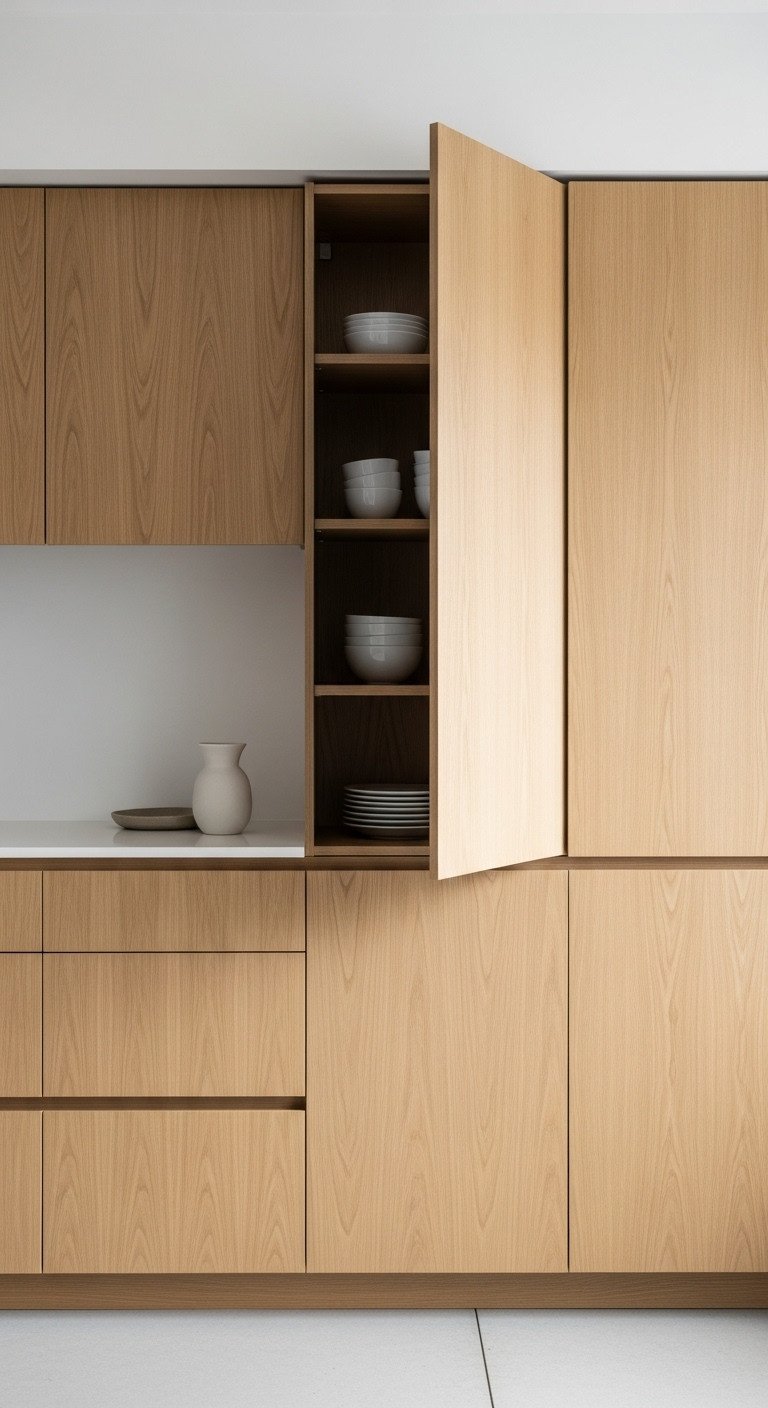
The cornerstone of a Zen kitchen is achieving an uncluttered look through clever, hidden storage. This means creating a seamless visual plane with handleless, flat-panel cabinets and integrated appliances, allowing the beauty of the materials to take center stage. The goal is to keep countertops almost completely clear, hiding away everything from your toaster to your utensil crock.
- Materials Needed: Flat-panel cabinet doors, push-to-open cabinet hardware mechanisms, integrated appliance panels, drawer organizers.
- Step-by-Step Directions:
- Plan your storage meticulously. Designate a specific home for every item to avoid countertop clutter.
- Retrofit existing cabinets or choose new ones with completely flat, handleless fronts.
- Install high-quality push-to-open latches. This hardware allows you to open doors and drawers with a simple press, eliminating the need for visual hardware.
- Opt for built-in or panel-ready appliances that can be covered with a panel matching your cabinetry, creating a seamless, uninterrupted look.
Pro-Tip: Invest in heavy-duty push-to-open hardware for frequently used cabinets like the trash pull-out. Cheaper mechanisms can fail over time with heavy use.
Save this minimalist storage idea to your ‘Dream Kitchen’ board!
2. Bring Nature Indoors with Organic Materials
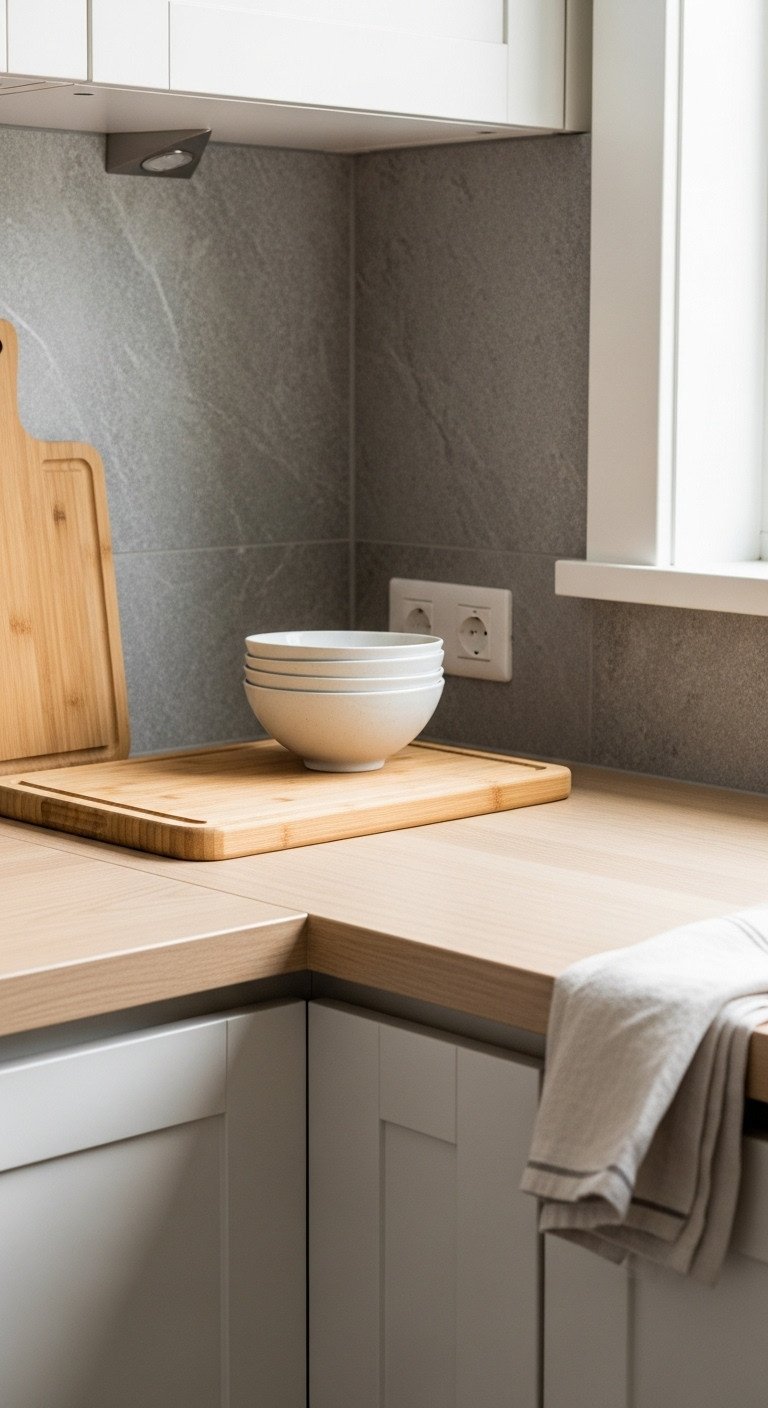
To create a truly harmonious space, use natural materials like wood, stone, and bamboo to ground your kitchen’s design. These organic elements provide warmth, texture, and a vital connection to the outside world, preventing a minimalist design from feeling cold or sterile. The interplay of different natural textures is key to creating a rich and inviting environment.
- Materials Needed: Wood, stone, or bamboo elements.
- Step-by-Step Directions:
- Choose a primary wood tone. Light woods like white oak, ash, or maple work beautifully for flooring, cabinets, or countertops.
- Select a complementary stone. A honed (matte) finish on granite or quartz countertops or a natural slate backsplash adds texture without unwanted shine.
- Layer in smaller natural elements. Incorporate a high-quality bamboo utensil set, linen dish towels, and simple, handmade ceramic bowls to complete the look.
Lesson Learned: Always seal wood countertops with a food-safe finish and re-apply it every 6-12 months to protect them from water damage and stains.
Pin this beautiful natural texture inspiration for later!
3. Create Calm with a Muted Color Palette
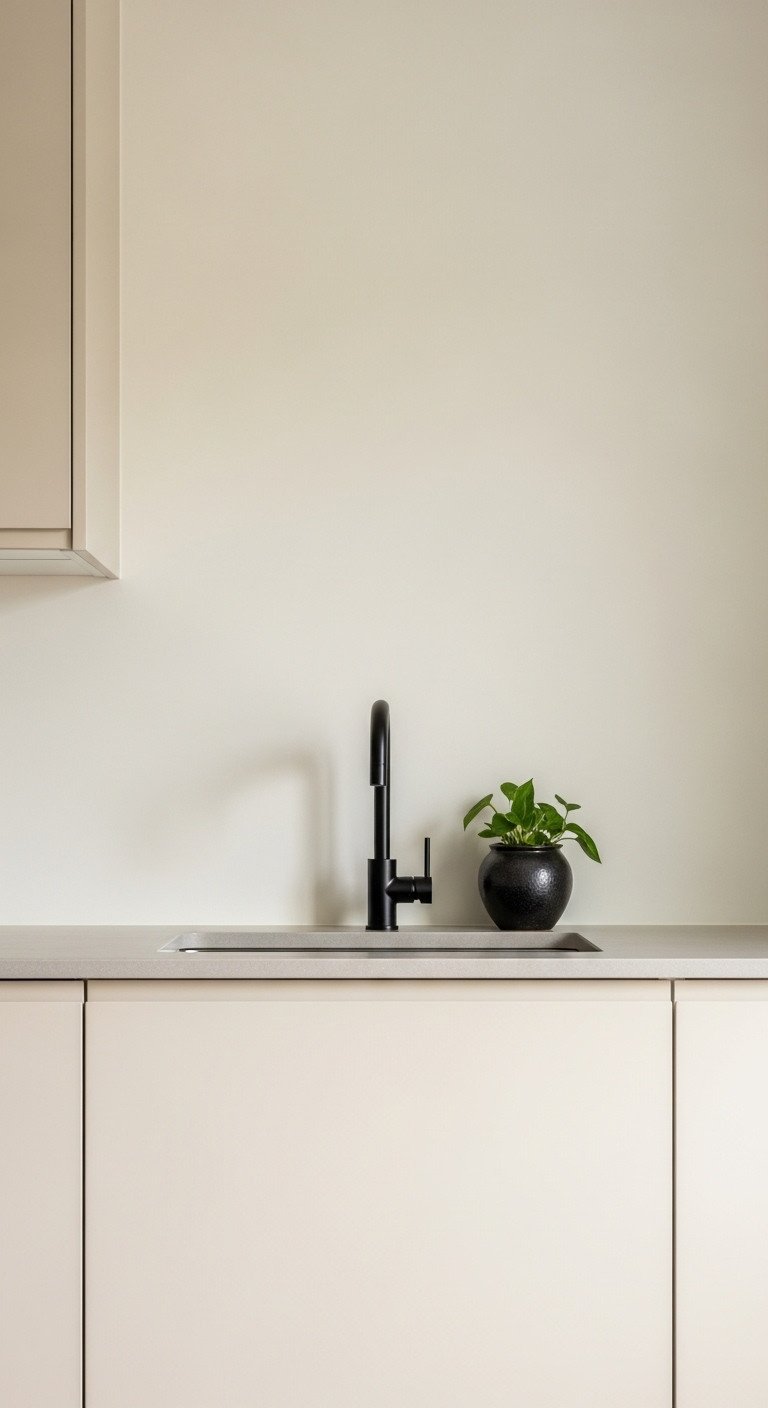
A Zen kitchen’s color scheme is built on a foundation of soft, muted, and earthy tones. Think of colors that you would find in nature: the soft white of a cloud, the warm beige of sand, the gentle gray of a river stone. This neutral backdrop creates a visually quiet space that calms the mind and allows the textures of your natural materials to shine.
- Materials Needed: High-quality interior paint in neutral shades, paint rollers, brushes, painter’s tape.
- Step-by-Step Directions:
- Choose a primary light neutral. Select a base color like warm white, soft beige, or light greige for your walls and cabinets.
- Layer in other earthy tones. Use slightly different shades of your primary color for depth, or add in tones of wood and stone.
- Add a touch of contrast. Use matte black or dark bronze for fixtures, faucets, or a single piece of decor to ground the space and add a modern edge. A specialized kitchen cabinet paint kit can make this process much easier for DIYers.
Pro-Tip: Always get paint samples and test them on your walls. The color can look dramatically different depending on the natural light in your specific kitchen.
Love this calming color scheme? Save it to your ‘Home Palette’ board!
4. Maximize Efficiency with Smart Organization
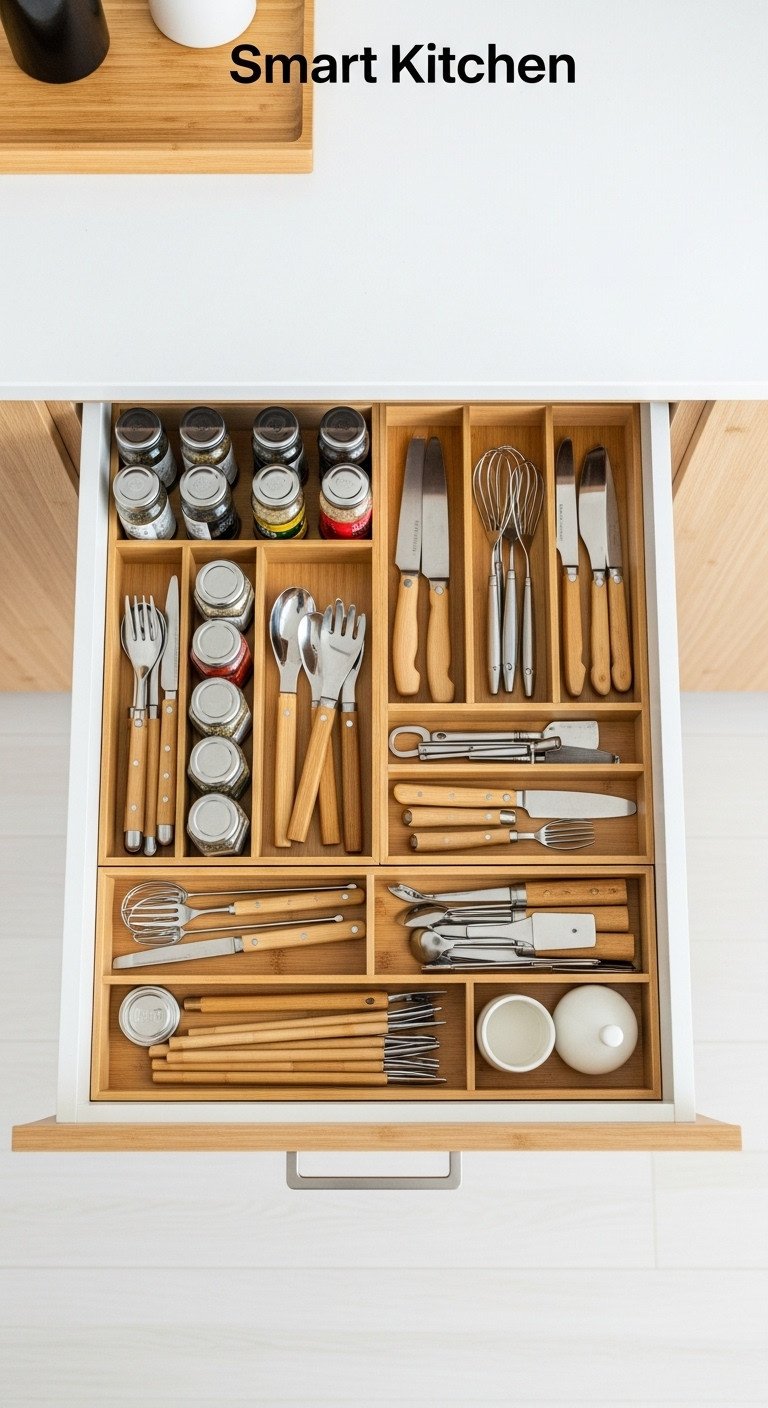
In a Japanese Zen kitchen, organization is about creating functional zones and effortless flow. It’s not just about hiding things, but about making sure everything is stored logically and is easy to access. A well-organized kitchen is a joy to use, reducing friction and making cooking a smoother, more mindful process.
- Materials Needed: Pull-out cabinet organizers, adjustable drawer dividers, blind corner cabinet solutions.
- Step-by-Step Directions:
- Define your kitchen zones: group items for cooking near the stove, prep tools near a clear countertop, and cleaning supplies under the sink.
- Install pull-out shelves in your lower cabinets. This allows you to see and reach everything without digging into the back of a dark cabinet. A heavy-duty pull-out cabinet organizer is a game-changer for pots and pans.
- Use adjustable drawer dividers to create custom compartments for utensils, spices, and tools. This prevents items from sliding around and becoming a jumbled mess.
Pro-Tip: Before buying any internal organizers, measure your cabinets and drawers three times! Pay close attention to interior width, depth, and height, and account for any hinges or pipes.
Get inspired to organize! Pin this clever drawer idea.
5. Illuminate with Soft, Natural Light
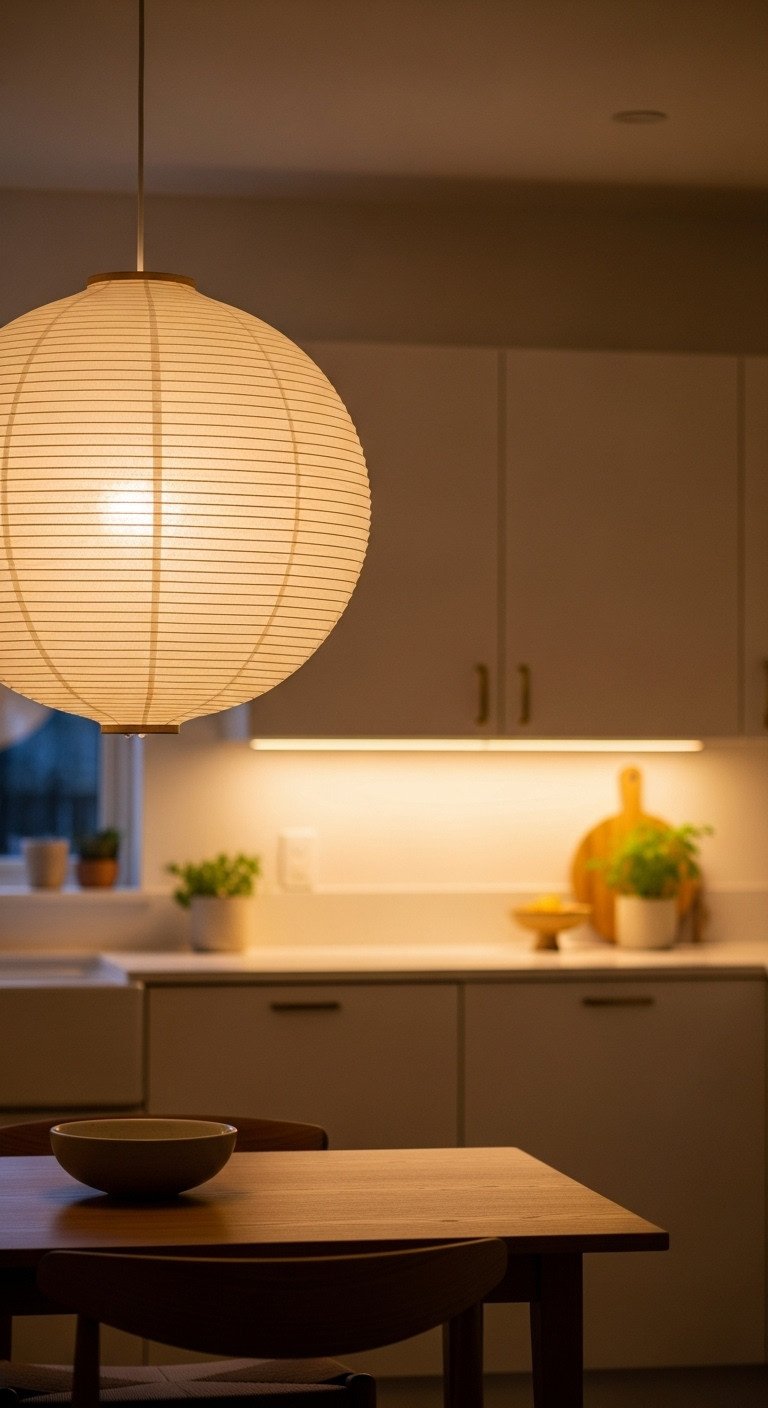
Lighting in a Zen kitchen should be soft, warm, and layered, with an emphasis on maximizing natural daylight. The goal is to create an inviting ambiance that feels open and airy during the day and cozy and intimate at night. Avoid harsh, direct overhead lighting, which can create glare and an unwelcoming atmosphere.
- Materials Needed: Large windows or sheer blinds, rice paper lantern pendant light, dimmable under-cabinet LED lighting kit.
- Step-by-Step Directions:
- Maximize natural light by keeping window treatments minimal. Use sheer linen blinds or rice paper screens that diffuse light without blocking it.
- For ambient light, hang a statement pendant light made from natural materials, like a classic Japanese paper lantern, over an island or dining area.
- For task lighting, install a warm-white, dimmable under-cabinet LED lighting kit. This provides clear, direct light onto your work surfaces without creating harsh overhead glare.
Pro-Tip: Choose LED lights with a warm temperature (2700K-3000K) to replicate the cozy glow of incandescent bulbs, which is much more in line with the Zen aesthetic than cool, blue-toned light.
Pin this beautiful lighting idea to brighten your kitchen design board!
6. Add Life with Mindful Greenery
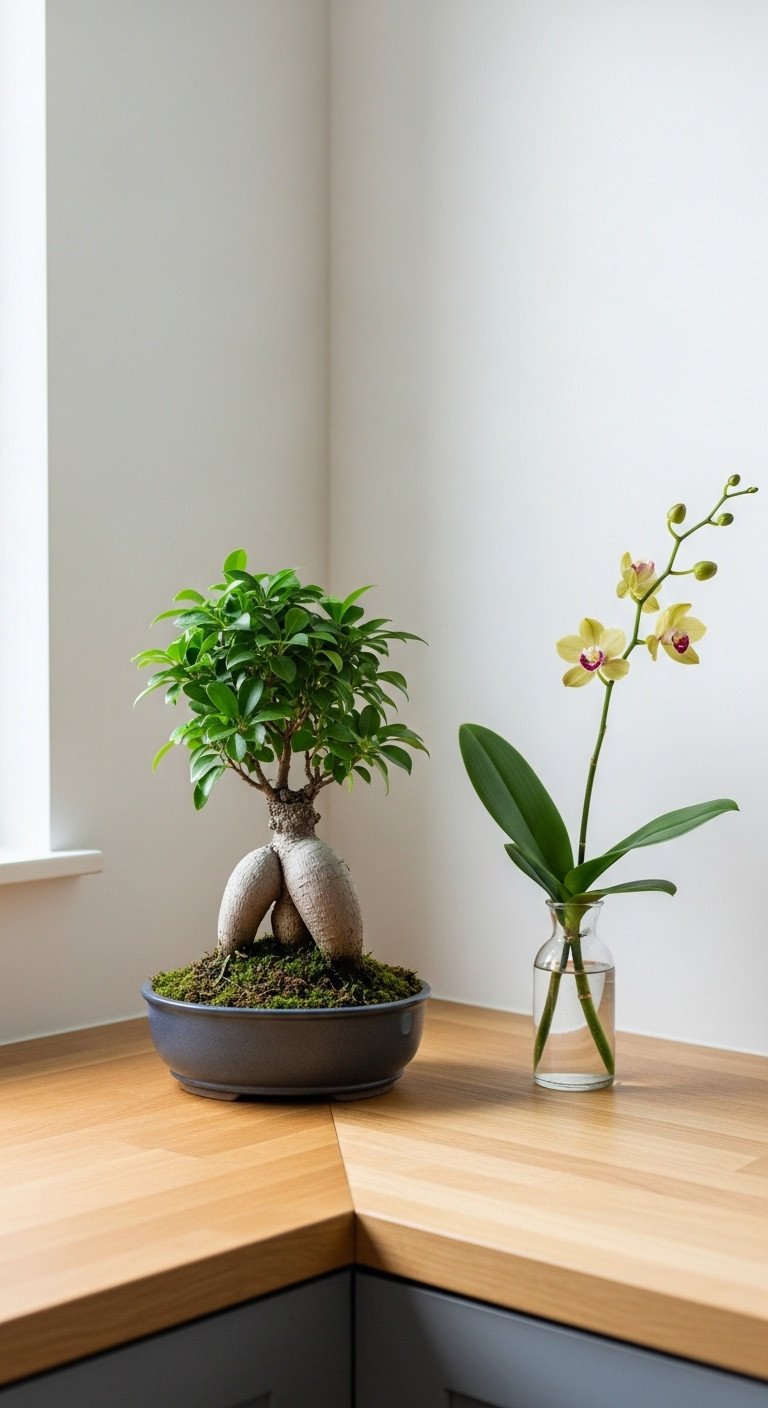
Incorporate plants not as clutter, but as living sculptures that add a touch of nature and vitality. The key is mindful placement and selecting plants with simple, elegant forms. A single, well-chosen plant can serve as a beautiful focal point and reinforce the kitchen’s connection to the natural world.
- Materials Needed: Small indoor plants (e.g., bonsai, snake plant, pothos), minimalist ceramic planters, small stones or moss for decoration.
- Step-by-Step Directions:
- Choose plants with simple, sculptural forms. A small bonsai tree, a single orchid, or a few succulents are excellent choices.
- Select the right container. Use simple, high-quality ceramic pots in neutral or earthy tones that complement your kitchen’s color palette. A set of small ceramic planters is perfect for a windowsill herb garden.
- Practice mindful placement. Instead of filling every surface with plants, place one or two strategically to act as a living sculpture and a focal point.
Lesson Learned: Bonsai trees require specific care. Research the needs of your chosen species; most need bright, indirect light and careful watering to thrive indoors.
Save this beautiful touch of nature for your kitchen decor inspiration!
7. Select Sleek, Minimalist Fixtures
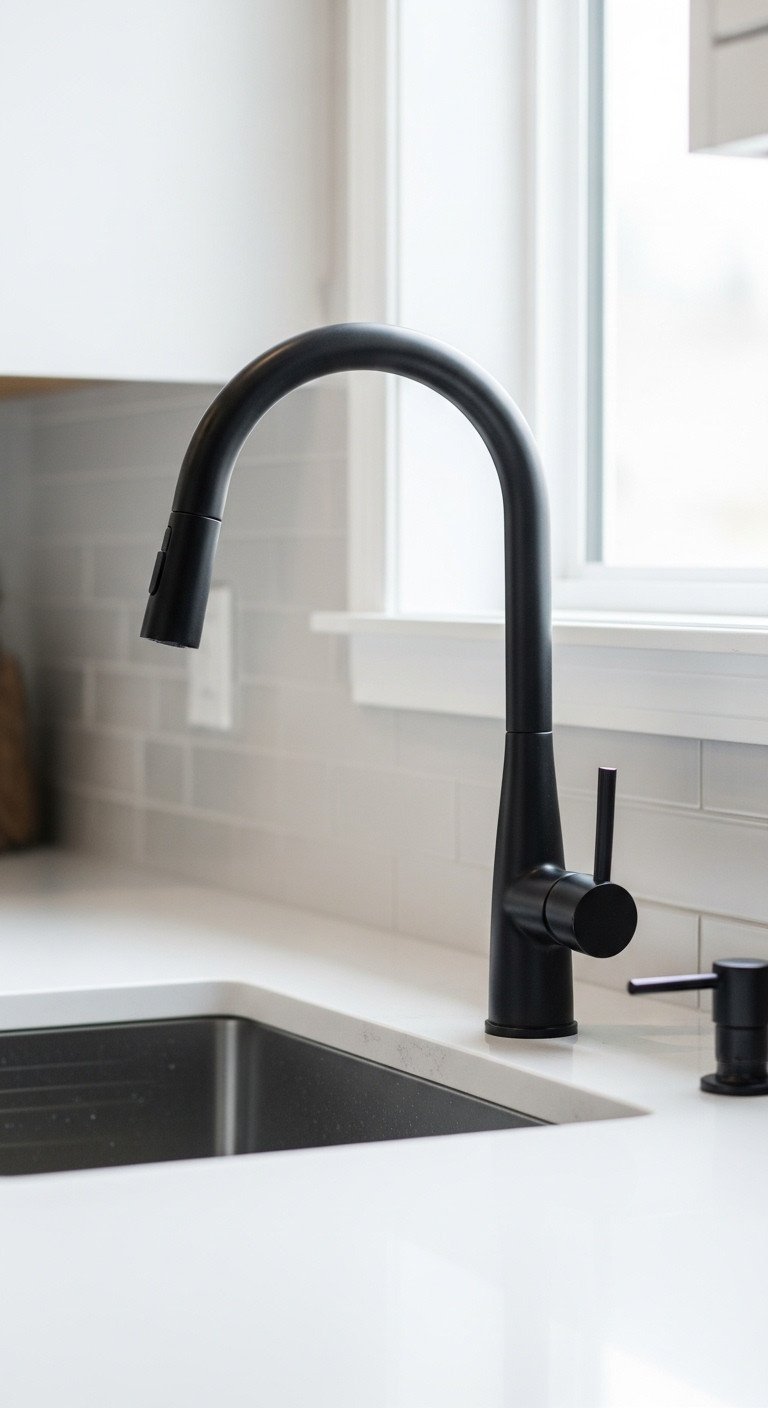
Fixtures and hardware should blend seamlessly into the design rather than standing out. Choose faucets, sinks, and other elements with clean, simple lines and unadorned forms. A matte black or brushed metal finish adds a touch of modern sophistication without creating visual distraction.
- Materials Needed: Minimalist faucet, undermount sink, handleless cabinet hardware.
- Step-by-Step Directions:
- Choose fixtures with clean, simple lines. Avoid ornate details. A high-arc, single-handle gooseneck faucet in a matte black or brushed finish is a perfect choice.
- Pair it with an undermount sink. This creates a seamless transition from countertop to sink, making it easy to clean and maintaining an uncluttered visual line.
- Ensure all hardware is cohesive. If you choose matte black for your faucet, consider using it for any other visible elements, though the ideal is to have as few visible elements as possible.
Pro-Tip: Look for faucets with a PVD (Physical Vapor Deposition) finish. This is a more durable finish that is highly resistant to scratching, tarnishing, and corrosion, making it ideal for a high-use item like a kitchen faucet.
Pin this sleek fixture idea for a modern kitchen upgrade!
8. Blend Warmth and Minimalism with Japandi Style
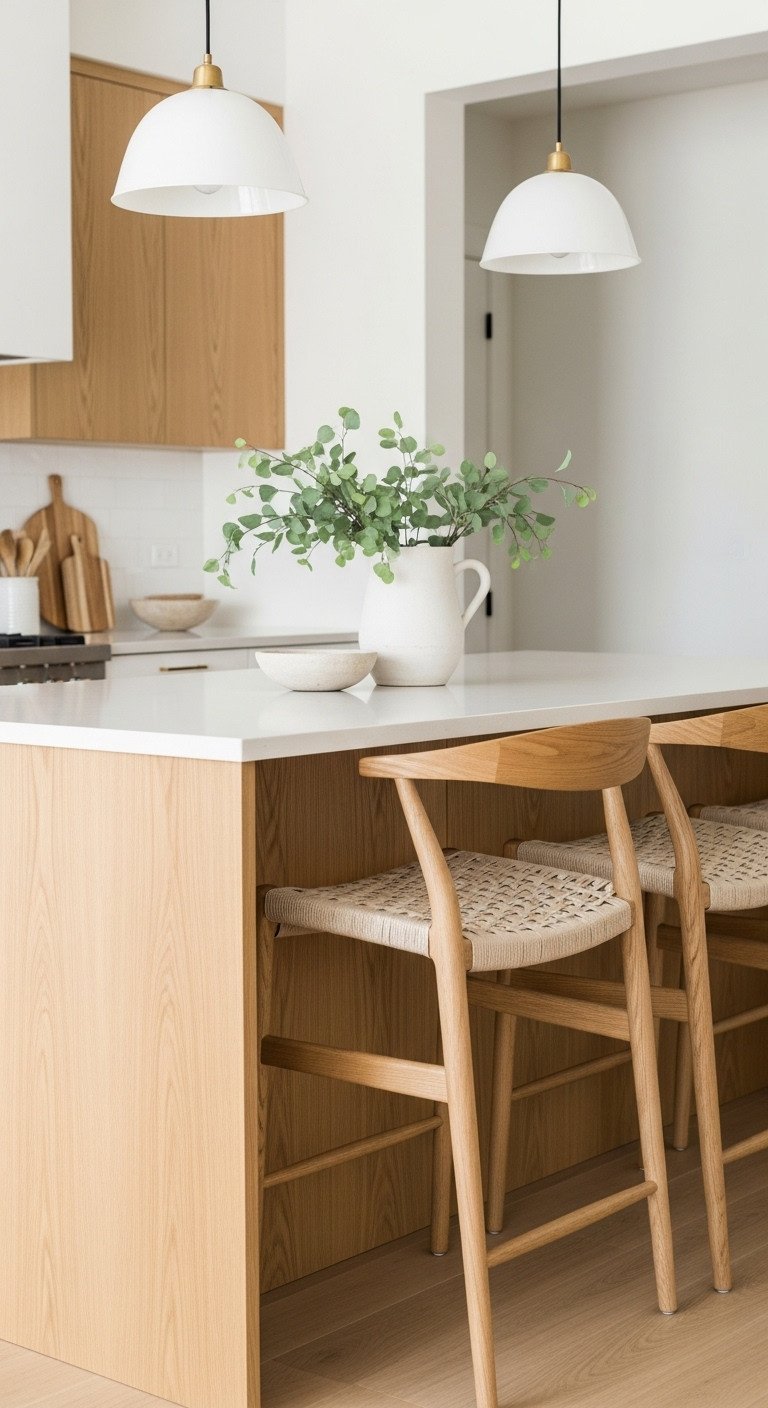
Japandi design is a hybrid style that perfectly marries Japanese minimalism with Scandinavian warmth and functionality. This fusion is ideal for creating a Zen kitchen that feels serene but also cozy and livable. It embraces clean lines and natural materials while adding soft textures and comfortable, functional furniture.
- Materials Needed: Light wood furniture or accents, cozy natural textiles, minimalist decor.
- Step-by-Step Directions:
- Combine different wood tones. Use the Japanese principle of clean lines for your cabinetry, but introduce the Scandinavian love for warm, light woods through furniture like a set of classic Scandinavian-style bar stools.
- Add cozy textures. Soften the minimalist lines with natural textiles like linen tea towels, a simple wool rug, or woven placemats.
- Prioritize functional comfort. The Japandi style is not just about looks; it’s about creating a livable, comfortable space. Ensure seating is ergonomic and layouts are practical.
Pro-Tip: The key to Japandi is the contrast in textures. Pair smooth, sleek surfaces (like a quartz countertop) with rougher, natural ones (like a raw wood stool or a slubby linen towel) to create visual interest and warmth.
Love the Japandi look? Save this idea to your ‘Interior Design’ board!
9. Personalize with Thoughtful, Artisanal Decor
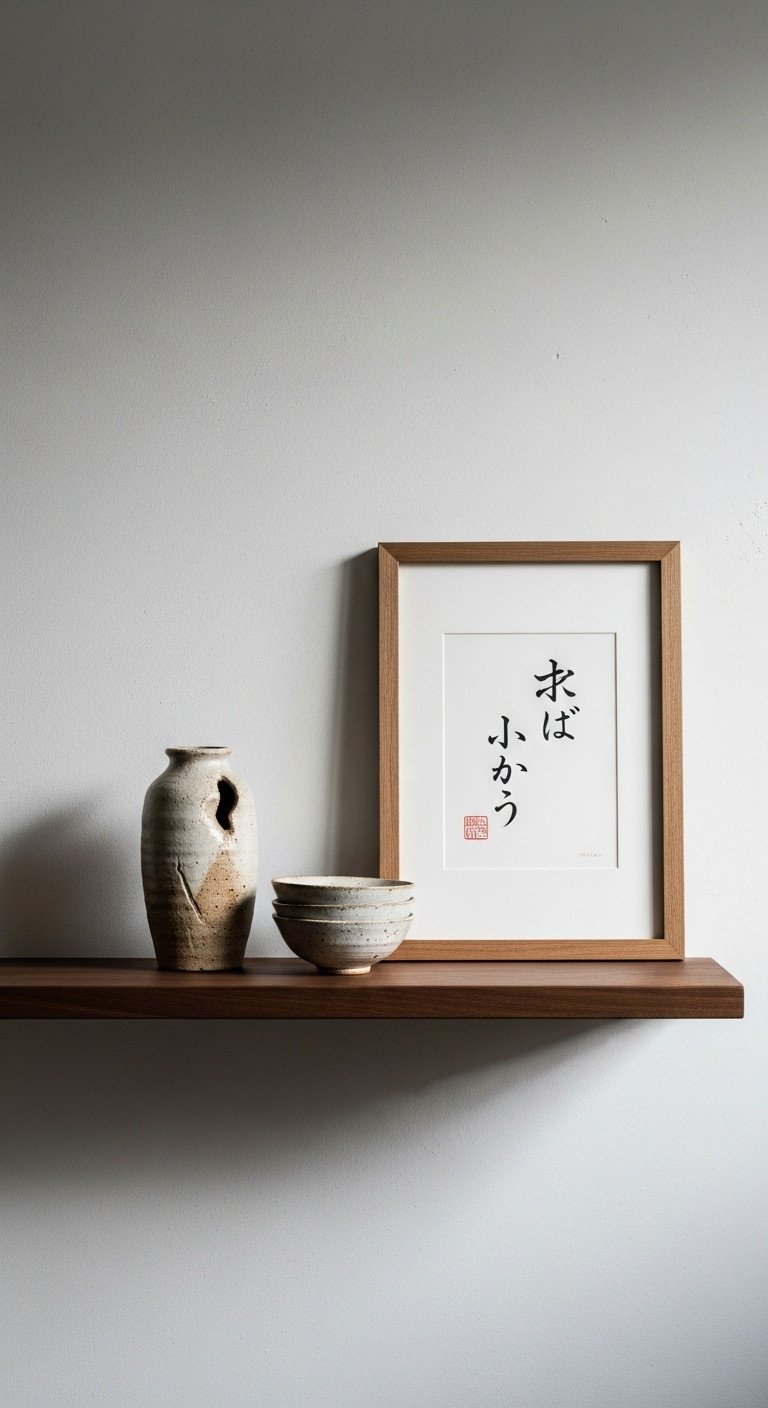
Minimalism doesn’t mean a lack of personality; it means choosing decor that is purposeful, beautiful, and meaningful. Instead of generic decorations, select a few artisanal items that tell a story. This approach, rooted in the wabi-sabi philosophy of finding beauty in imperfection, adds soul and character to your space.
- Materials Needed: Floating shelves, curated decorative objects (vases, bowls), simple wall art.
- Step-by-Step Directions:
- Follow the “less is more” principle. Choose only a few decorative items that have personal meaning or exceptional beauty.
- Focus on texture and imperfection. Look for artisanal pieces like handmade ceramics. A wabi-sabi ceramic vase, which celebrates the beauty of imperfection, is a perfect addition.
- Create a small, curated display. Use a single floating shelf to group 2-3 items together, creating a purposeful vignette rather than scattering items throughout the kitchen.
Pro-Tip: Rotate your decor seasonally. This keeps the space feeling fresh and allows you to enjoy more of your beautiful objects without having them all out at once.
Pin this artistic decor idea for a touch of personality!
10. Enhance Flow with Open, Multi-functional Spaces
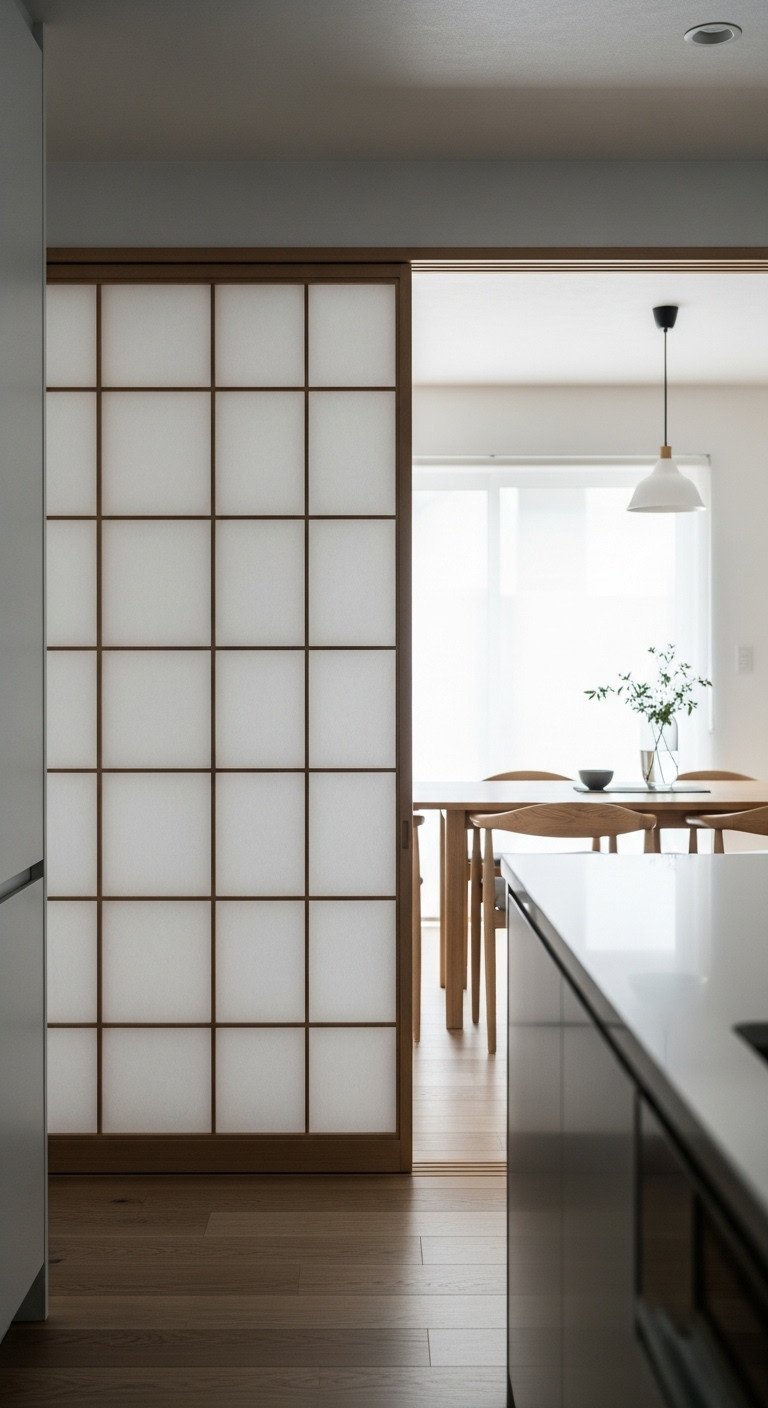
A Zen kitchen often feels larger and more peaceful because it promotes a sense of openness and connection to adjacent rooms. Creating an open layout, or using clever dividers like shoji screens, allows energy and light to flow freely, making the entire area feel like one large, harmonious space.
- Materials Needed: Sliding doors or a portable room divider screen.
- Step-by-Step Directions:
- Assess your layout. If a full renovation isn’t possible, consider removing non-structural walls or widening doorways to connect the kitchen to adjacent living or dining areas.
- Use flexible dividers. To create separation without closing off the space entirely, use translucent dividers that allow light to pass through. A traditional Japanese shoji screen room divider is both beautiful and functional for this purpose.
- Ensure a consistent flow of materials. Use the same flooring and a consistent color palette between the kitchen and adjoining rooms to enhance the sense of a single, large, harmonious space.
Pro-Tip: Portable, folding shoji screens are a great, non-permanent option for renters or for those who want the flexibility to change their layout for different occasions.
Save this clever idea for creating open, yet defined, spaces!
11. Invest in Quality Craftsmanship
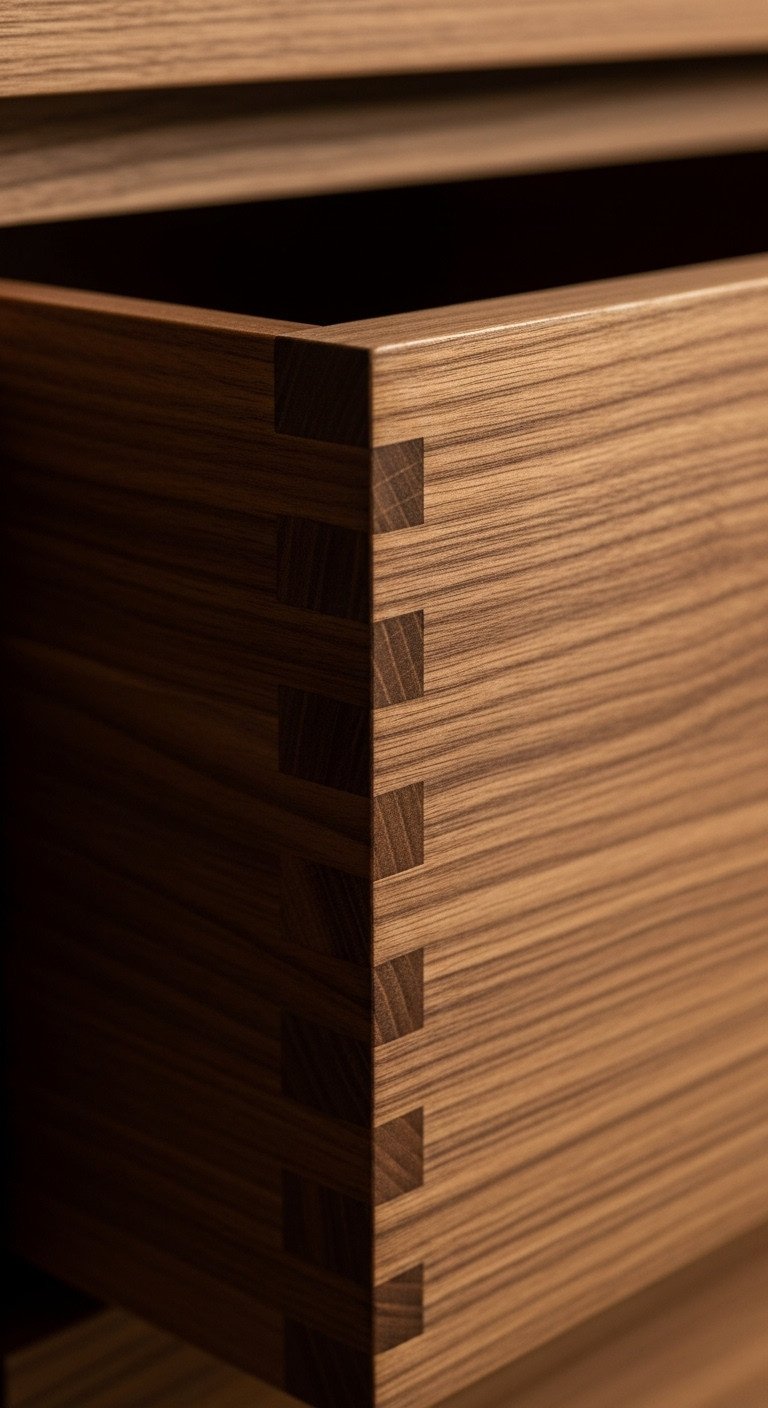
The Zen philosophy encourages mindful living, which includes choosing durable, well-made items over disposable ones. Investing in quality craftsmanship for your cabinets, cookware, and tools not only enhances the kitchen’s beauty but also aligns with a more sustainable and intentional way of life.
- Materials Needed: Investment pieces made from solid, durable materials.
- Step-by-Step Directions:
- Prioritize quality over quantity. Instead of buying a large set of cheap knives, invest in one or two high-quality Japanese chef’s knives.
- Choose solid materials. Opt for solid wood over particleboard for cabinets, and select well-made tools and cookware that will last a lifetime. A thick, end-grain solid wood cutting board is both a beautiful and a long-lasting work surface.
- Appreciate the details. Look for signs of good craftsmanship, like dovetail joints in drawers or the balanced weight of a well-made pan. These are the elements that contribute to a serene and sophisticated aesthetic.
Lesson Learned: While quality pieces may have a higher upfront cost, they save money in the long run by not needing to be replaced. This “buy it for life” mentality is a core tenet of mindful, Zen-inspired living.
A reminder that quality matters! Pin this craftsmanship inspiration.
Key Takeaways: Your Quick Guide to a Japanese Zen Kitchen
- Minimalism is Key: Keep countertops clear and ensure every item has a purpose and a place. Prioritize hidden storage.
- Embrace Nature: Use organic materials like wood, stone, and bamboo, and incorporate mindful greenery.
- Calm Color Palette: Stick to soft, neutral, and earthy tones like whites, beiges, and grays, with black as a grounding accent.
- Focus on Light: Maximize natural daylight and use soft, diffused artificial lighting to create a warm, inviting ambiance.
- Quality Over Quantity: Invest in well-crafted, durable items that will stand the test of time.
People Also Ask About Japanese Zen Kitchen
What is Japanese Zen style?
Japanese Zen style is a design philosophy focused on creating serene, harmonious, and uncluttered spaces. It emphasizes simplicity, natural materials, and a deep connection to nature. In architecture and interior design, this translates to clean lines, minimalist decor, neutral color palettes, and a layout that promotes a sense of peace and tranquility.
What is a Japandi kitchen?
A Japandi kitchen is a popular hybrid design style that blends Japanese minimalism with Scandinavian functionality and warmth. It takes the “less is more” philosophy and clean lines from Japanese design and combines them with the cozy textures, light woods, and functional comfort characteristic of Scandinavian aesthetics, resulting in a space that is both serene and inviting.
What is a traditional Japanese kitchen called?
A traditional Japanese kitchen is called a “Daidokoro” (台所). Historically, it was also referred to as “Kamado” (かまど), which means stove, as the stove was considered the symbolic heart of the home. Modern Japanese kitchens still often incorporate the core principles of efficiency and simplicity found in the traditional Daidokoro.
How do you design a Japandi kitchen?
To design a Japandi kitchen, focus on a foundation of clean lines and hidden storage. Use natural materials, especially light-toned woods like oak or ash. Stick to a neutral color palette of whites, beiges, and grays, but add warmth with cozy textiles and contrasting dark accents. Finally, choose simple, well-crafted furniture and decor that is both beautiful and functional.
Final Thoughts
Creating a Japanese Zen kitchen is about so much more than following a design trend; it’s about crafting an environment that supports a calmer, more mindful way of life. It’s an investment in your own well-being. By thoughtfully decluttering, embracing natural beauty, and prioritizing quality, you’re not just remodeling a room—you’re creating a sanctuary. By incorporating these ideas, you can transform your kitchen from a place of chaos into the serene heart of your home. Which of these Zen design ideas are you most excited to try first? Let us know in the comments below
Last update on 2025-10-14 at 22:55 / Affiliate links / Images from Amazon Product Advertising API
